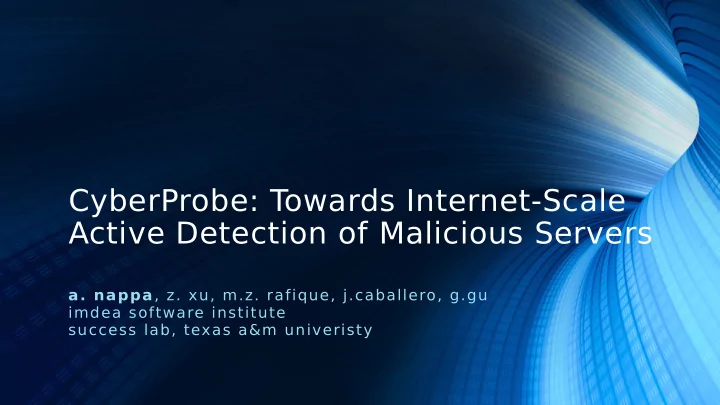

CyberProbe: Towards Internet-Scale Active Detection of Malicious Servers a. nappa , z. xu, m.z. rafique, j.caballero, g.gu imdea software institute success lab, texas a&m univeristy
Cybercriminals use geographically distributed servers to run their malicious operations • Exploit servers -> Malware distribution • Payment servers -> Monetization • Redirectors -> Anonymity • C&C servers -> Control botnets • P2P bots (server functionality)
What is CyberProbe Paunch’s Operation BENIGN MALICIOU S
Existing detection techniques: Passive • Honeypots • Spamtraps • LIMITATIONS - Slow - Incomplete (i.e., limited view)
Existing detection techniques: Active • Run malware samples • Honeyclient farms (i.e. Google Safebrowsing ) • LIMITATIONS - Expensive - Incomplete (i.e., Safebrowsing focuses on exploit servers)
Contributions • Novel active probing approach for Internet-scale detection of malicious servers • Novel adversarial fingerprint generation technique • Implement approach into CyberProbe • Use CyberProbe for 24 localized and Internet-wide scans • Identifies 151 malicious servers • 75% of the servers unknown to databases of malicious activity (e.g., VirusT otal, UrlQuery) • Identifies provider locality property
Cyberprobe in a nutshell Adversarial Network traces Fingerprints Fingerprint Generation Benign Traffic Seed Servers Port Malicious Scanning T arget Ranges Servers Fingerprint
Fingerprints • A fingerprint for each operation & server type • A fingerprint comprises: • A probe construction function Packet • A classification function Snort signature Clickpayz1 Probe: GET /td?aid=e9xmkgg5h6&said=26427 Signature: content: “302”; http_stat_code; content: “\r\n\r\nLoading…”
Adversarial Fingerprint Generation: Goals • Minimize traffic • Generate inconspicuous probes
Adversarial Fingerprint Generation: Architecture Benign T raffic RRP s SIGNATURE REPLAY CLUSTERIN Cluster RRP GENERATIO THROUGH RRPs FP G EXTRACTION N VPN EDP s SEEDS
Generation details • Replay • VPN for: anonymity, IP diversity and for new states • Check result against random resource from the server Compa re GET /td? aid=e9xmkgg5h6&said=26427 GET /asdfgh.html
Scanning • 3 scanners: • Horizontal SYN scan • AppTCP scanner (sends app-level probe) • UDP scanner • 3 scan ranges: • Localized-reduced • Localized-extended • Internet-wide • Signature matching uses Snort
AppTCP and UDP scanners INTERNET CyberPro be Benign Server Malicious Family A
Scanning summary TCP • TCP horizontal scanner (fast, polite) • TCP sniffer (reliable to get responses to our probes) • AppTCP scanner (Asynchronous + Snort) UDP • UDP scanner (fast, polite) + Snort
Ethical Considerations T o scan as politely as possible we: • Rate-limit scanners • Set up forward and backward DNS entries for scanners • Set up a webpage in the scanners to explain our experiment • Remove from whitelist provider’s ranges that request so • Manually check fingerprints
Adversarial fingerprint generation results Type Source Families Pcaps RRPs RRPs Seeds Fingerprint Replaye s r Malware VirusSha 152 918 1,639 193 19 18 re Malware MALICIA 9 1,059 764 602 2 2 Honeyclie MALICIA 6 1,400 42,160 9,497 5 2 nt Honeyclie UrlQuery 1 4 11 11 1 1 nt
AppTCP Scan Results • 151 total servers found with the scans 4x Better • Virustotal knew only about 25% of the Coverage servers • UrlQuery 15% • MalwareDomainList and VxVault 1%
Servers Operations Operation Fingerprint Seeds Servers Prov. Provider s Loc. bestav 3 4 23 7 3.3 bh2-adobe 1 1 13 7 1.8 bh2-ngen 1 1 2 2 1.0 blackrev 1 1 2 2 1.0 clickpayz 2 2 51 6 8.5 doubleighty 1 1 18 9 2.0 kovter 2 2 9 4 2.2 ironsource 1 1 7 4 1.7 optinstaller 1 1 18 4 2.0 soft196 1 1 8 4 2.0 TOTAL 14 15 151 47 3.2(avg.)
Observations Provider Locality: Once a relationship has been established with a provider it is very likely that more than one malicious server will be setup with this provider
P2P bots Scan Results Typ Start- Port Fingerpr Targets SC Rate Time Found e Date int R 2013-03- UDP/164 zeroacce 40,448 1 10 1.2h 55 (0.13%) 19 71 ss I 2013-05- UDP/164 zeroacce 2,6B 4 50,000 3.6h 7,884 03 71 ss (0.0003%)
Related Work Scanning: • Leonard et al. IMC ‘10 • Heninger et al. Usenix Security ’12 • Zmap Fingerprinting: • FiG • PeerPress Signature Generation: • Honeycomb, Autograph, EarlyBird, Polygraph, Hamsa • Botzilla, Perdisci et al., Firma
Conclusion • Novel active probing approach for Internet-scale detection of malicious servers • Novel adversarial fingerprint generation technique • Implement approach into CyberProbe • Use CyberProbe for 24 localized and Internet-wide scans • Identifies 151 malicious servers • 75% of the servers unknown to databases of malicious activity (e.g., VirusT otal, UrlQuery) • Identifies provider locality property
Thanks!
Future Work • Scanner IP diversity • Completeness Shared hosting (i.e. CDN) • • Complex protocol semantics
Recommend
More recommend